By Professor Tiffany Banks On Tuesday, September 30th , students from my COMM 108: Foundations…
Spring break crowds flooded the exhibition halls of the Smithsonian National Museum of Natural History this past week, putting even more pressure on our guides to deliver stimulating presentations
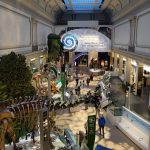
about their respective work. Fortunately, they were up for the challenge. Matthew Carrano, the Curator of Dinosauria in the Department of Paleobiology, wowed us with behind-the-scenes details of Deep Time’s multiyear renovation project while Siobhan Starrs, a lead Deep Time exhibition developer, spoke to innovations in the project’s accessibility and inclusion mission. Later, Jennifer Collins, Manager of Ocean Education and Outreach at the SNMNH, and Bayley McKeon, an Ocean Education Specialist, invited us on a series of educational tours dedicated to Sant Ocean Hall.
We never left the classroom space reserved by Philippa Rappoport and the SNMNH’s presenting team, but, as the fellows attest below, it didn’t take much for us to be transported, lost in the dynamic experience that is renewing museum education.
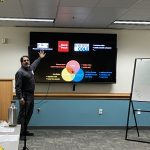
Before Deep Time closed its doors in 2013 for renovation, the content had been on display for 30 years and was the oldest fossils exhibit at that time. Carrano revealed, though, that the museum was behind the curve when it came to updating the exhibit, a concept that fascinated the fellows, especially Professor Evan Crump. Thanks to one of Crump’s questions during the presentation, in fact, we learned Jurassic Park paved the way for new scientific inquiry and even created job opportunities for folks invested in dinosaur curation. Crump explains, “This means we had a set of ’90s-era creatives (Crichton, Spielberg, etc.) inspired by 19th- and 20th-century science to create media (science fiction) which in turn fed back into science and allowed the field to advance much further in the 21st century.” As Crump’s Smithsonian Faculty Fellowship-inspired project continues to take shape, he shares, “I want to know more about this positive feedback loop and how it continues to influence the production of museum exhibits and sci-fi.”
The stories that fascinate us in popular media are just one of many influences for the Deep Time team. At the start of the project, they established a set of guiding principles, including relevance, visitor needs, intuitive design, scientific perspective, and a careful blend of knowledge and facts. Their first revision objective? Determine the story. How does Earth’s past connect to the present and cultivate opportunity to address human impact on the future? To answer a complex question like this, the labor to follow was effortful to say the least, as Professor Ellen Olmstead underscores, “I had no idea about the timeframe, the pedagogy, the many different people involved, the flow through the exhibit.”
Indeed, to meet the new vision for the exhibit, the Deep Time team began quite the in-house excavation project. Entire dinosaur skeletons were dismantled piece by piece to be reassembled according to new narratives; others were updated to feature more accurate skeletal structures; The Nation’s T-Rex was shipped in via FedEx; a number of dinosaur skeletons and bones were fully-digitized, too. New

artworks were commissioned not only to provide the visual backdrop for the creatures on display but also to tie the disparate encased items together to tell a shared story. The underlying mission of these efforts is captured quite beautifully by Professor Serena Gould: “While part of the museum’s task is still functional, scientific knowledge is no longer ‘just facts’; the focus is geared towards making ‘deep time’ the theme and framework as relevant to all visitors.” For Gould, Deep Time is so exceptional in terms of museum design thanks to the curators’ efforts to “incorporat[e] and recogniz[e] the audience as the vital ‘other’ in the developing dialogue.”
This is where the exhibition development genius becomes essential. As an Exhibition Developer and Visitor Advocate, Siobhan Starrs is charged with keeping visitors happy so they stay longer, engage with more content, and absorb the exhibit’s message. Thoughtfully-spaced seating, big-format messaging, flow out avenues and quiet spaces, accessibility-driven applications, hyper-specific visual descriptions, a robust virtual tour—all contribute to a more inclusive learning space. Telling the difficult story of humankind’s irrevocable tie to climate change requires care and tact as well. The realities are daunting, and the SNMNH isn’t in the business of sugarcoating the truth; however, Earth Optimism has proven to be a more impactful philosophy for museum educators.
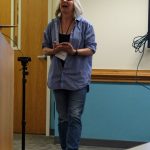
Best practices in Earth Optimism were shared across the presentations. For Starrs and her team, it helps to start with a recognizable environmental topic, such as a vulnerable creature or ecosystem folks
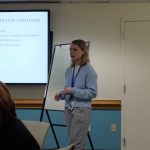
are already passionate about. This early investment makes visitors more open to tangible climate solutions. A similar approach is echoed in the work of Jennifer Collins and Bayley McKeon, both of whom are currently workshopping version 15 of the Human Connections tour in Sant Ocean Hall.
Originally, Collins and McKeon were scheduled to escort us through Sant Ocean Hall to deliver their tour, but the crowds forced them to get creative.
They began with a simple prompt: Take two deep breaths. Then, they quizzed us: How much oxygen comes from the ocean?
The answer is 50%!
This first little bit of trivia inspired the rich tour to follow. And, as Professor Teresa Lew exclaims, “What Bayley had to say about how we can thank the ocean, the phytoplankton, and the whales for the air we breathe is a strong reminder of our responsibility for environmental stewardship.” These words truly speak to the revised tour’s learning outcomes: bridge a human connection to real environmental problems, drive a shift in emotions, foster action. Their strategy for cultivating this work actually reminded me of my approach to writing in ENGL 101 at MC:
- Hook: First, it’s important to hook the audience. For example, in a tour specific to coral bleaching, McKeon shares a branch of bleached coral and draws attention to all the tiny holes scattered across its surface.
- Science Content: The coral is remarkably beautiful, but the science connection McKeon interweaves into its examination reveals a sad truth. Those tiny holes were once filled by zooxanthellae, but, under environmental stress, such as warming temperatures, corals expel the zooxanthellae, and the coral loses a major source of nourishment.
- Human Impacts: The human connection that follows this conversation pivots on the various human activities that contribute to coral bleaching.
- Concrete Solutions: The Global ARMS Program monitors the ever-changing ocean and uses Automonous Reef Monitoring Structures (ARMS) to analyze its health. On an individual basis, too, we can make a positive impact by choosing to wear chemical-free sunscreens when visiting vulnerable ecosystems, like coral reefs.
- Relevance: Biodiversity, coastal protection, a food resource—you name it, healthy coral is beneficial to so many of Earth’s creatures.
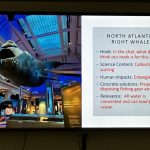 The intentional design of this tour was certainly well-received by a group of Montgomery College educators. We make for a friendly audience in most educational contexts, after all! Still, one can see why this is version 15 of their tour model. Many folks struggle to appreciate and even outright deny our contribution to climate change. Fortunately, these thoughtful educators, as Lew explains, “…allow us to understand the deeply interconnected relationships of all living species on earth.” They carefully set the stage for important conversations, they help us to recognize alarming realities, and they invite us to embrace optimism as we leave the museum and, ideally, honor our roles as environmental stewards.
The intentional design of this tour was certainly well-received by a group of Montgomery College educators. We make for a friendly audience in most educational contexts, after all! Still, one can see why this is version 15 of their tour model. Many folks struggle to appreciate and even outright deny our contribution to climate change. Fortunately, these thoughtful educators, as Lew explains, “…allow us to understand the deeply interconnected relationships of all living species on earth.” They carefully set the stage for important conversations, they help us to recognize alarming realities, and they invite us to embrace optimism as we leave the museum and, ideally, honor our roles as environmental stewards.
Thank you, Matt, Siobhan, Jennifer, and Bayley, for another rich day of learning! After our visit, most fellows raced to Deep Time to experience the exhibit in person. Professor
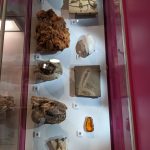 Theodore Shusterman shared a couple of photos from his exploration, including “insects preserved in amber a la Jurassic Park, and the recreation
Theodore Shusterman shared a couple of photos from his exploration, including “insects preserved in amber a la Jurassic Park, and the recreation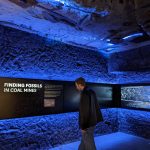
of the coal mine in West Virginia that contained a layer of fossilized materials.” Inspiration, education, and entertainment abound!
To learn more about our visit, please explore Philippa Rappoport’s Smithsonian Learning Lab collection, which serves as the fellows’ introduction to both Many Voices, One Nation and Entertainment Nation: https://learninglab.si.edu/q/ll-c/d0cDQW8OXeiAz9PZ.
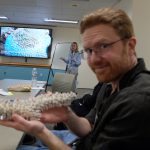
Photos by Denise Dewhurst
Photos by Matt Decker
Photos by Theodore Shusterman




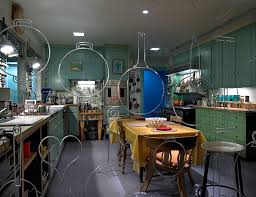
These museum visits have been phenomenal, and it is so inspiring to hear from all of the different curators, exhibition developers, educators, and specialists! I also found such great parallels between Bayley’s approach to exhibit tours and English composition classes. In fact, I feel the need to design a new essay assignment titled “Argumentation the Smithsonian Way” based off her approach.
Let’s workshop that idea together, Teresa. I love this idea. It would be so fun to invite our students to any museum, ask them to locate an artifact of importance, and then invite them to write a paper “the Smithsonian Way”!